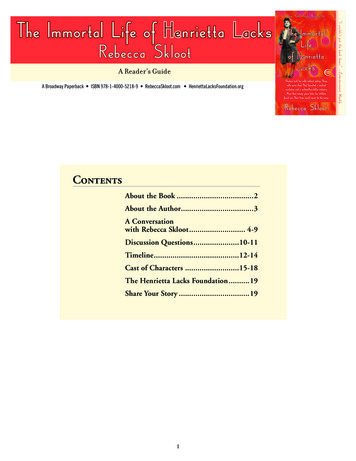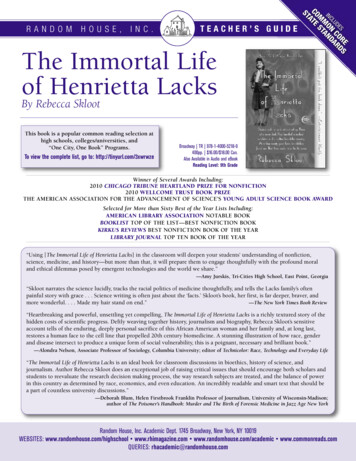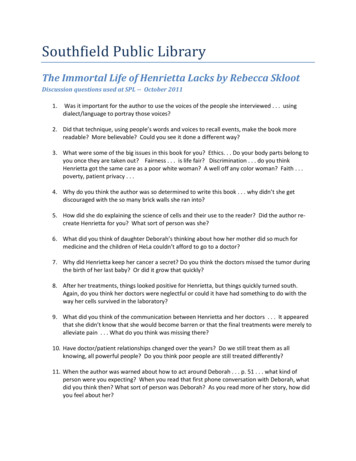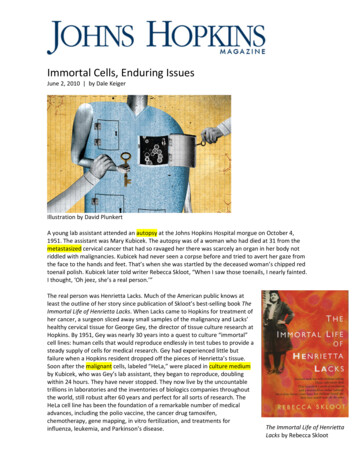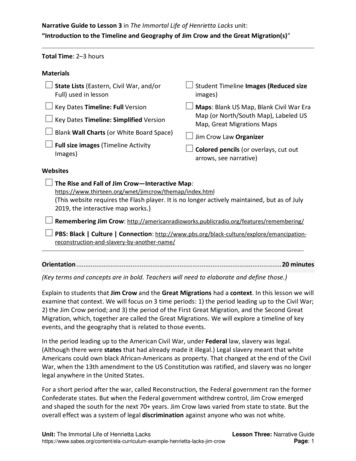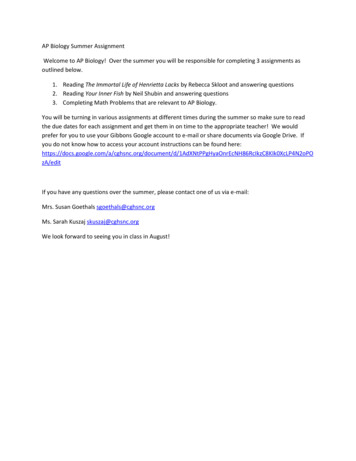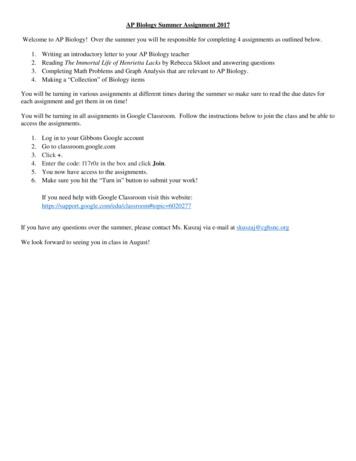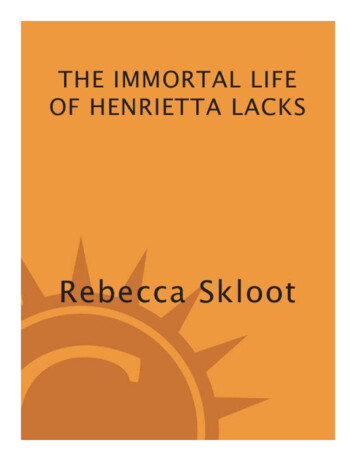
Transcription
Skloot, Rebecca - The Immortal Life OfHenrietta LacksThe Immortal life of Henrietta LacksEARLY PRAISE FORThe IMMORTAL LIFE of HENRIETTA LACKS“Skloot makes a remarkable debut with this multilayered story about ‘faith, science, journalism, and grace.’”—PUBLISHERS WEEKLY (starred review)“Heartbreaking and powerful, Rebecca Skloot’s sensitive account tells of the enduring,deeply personal sacrifice of this African American woman and her family and, at long last, restores a human face to the cell line that propelled 20th-century biomedicine. A stunning illustration of how race, gender, and disease intersect to produce a unique form of social vulnerability, this is a poignant, necessary, and brilliant book.”—ALONDRA NELSON, Columbia University; editor of Technicolor: Race, Technology andEveryday Life“The Immortal Life of Henrietta Lackstakes the reader on a remarkable journey—compassionate, troubling, funny, smart, and irresistible. Along the way, Rebecca Skloot will change the way you see medical science andlead you to wonder who we should value more—the researcher or the research subject? Ethically fascinating and completely engaging—I couldn’t recommend it more.”—DEBORAH BLUM, author of The Poisoner’s Handbook“This is a science biography like the world has never seen Ladies and gentlemen, meetHenrietta Lacks. Chances are, at the level of your DNA, your inoculations, your physicalhealth and microscopic well-being, you’ve already been introduced.”—MELISSA FAY GREENE, author of Praying for Sheetrock and There Is No Me WithoutYou“Remarkable The portrayal of Lacks’s full life makes the story come alive with her humanity and the palpable relationship between race, science, and exploitation.”—PAULA J. GIDDINGS, author of Ida, a Sword Among Lions; Elizabeth A. Woodson 1922Professor, Afro-American Studies, Smith College“This book is extraordinary. As a writer and a human being, Skloot stands way, way outthere ahead of the pack.”—MARY ROACH, author of Stiff and Bonk
The Immortal life of Henrietta LacksThe Immortal life of Henrietta LacksFor my family:My parents, Betsy and Floyd; their spouses, Terry and Beverly;my brother and sister-in-law, Matt and Renee;and my wonderful nephews, Nick and Justin.They all did without me for far too long because of this book,but never stopped believing in it, or me.And in loving memory of my grandfather,James Robert Lee (1912–2003),who treasured books more than anyone I’ve known.The Immortal life of Henrietta LacksContentsA Few Words About This BookPrologue: The Woman in the PhotographDeborah’s VoicePart OneLIFE
1. The Exam 19512. Clover 1920–19423. Diagnosis and Treatment 19514. The Birth of HeLa 19515. “Blackness Be Spreadin All Inside” 19516. “Lady’s on the Phone” 19997. The Death and Life of Cell Culture 19518. “A Miserable Specimen” 19519. Turner Station 199910. The Other Side of the Tracks 199911. “The Devil of Pain Itself” 1951Part TwoDEATH12. The Storm 195113. The HeLa Factory 1951–195314. Helen Lane 1953–195415. “Too Young to Remember” 1951–196516. “Spending Eternity in the Same Place” 199917. Illegal, Immoral, and Deplorable 1954–196618. “Strangest Hybrid” 1960–196619. “The Most Critical Time on This Earth Is Now” 1966–197320. The HeLa Bomb 196621. Night Doctors 200022. “The Fame She So Richly Deserves” 1970–1973Part Three
IMMORTALITY23. “It’s Alive” 1973–197424. “Least They Can Do” 197525. “Who Told You You Could Sell My Spleen?” 1976–198826. Breach of Privacy 1980–1985Photo Insert27. The Secret of Immortality 1984–199528. After London 1996–199929. A Village of Henriettas 200030. Zakariyya 200031. Hela, Goddess of Death 2000–200132. “All That’s My Mother” 200133. The Hospital for the Negro Insane 200134. The Medical Records 200135. Soul Cleansing 200136. Heavenly Bodies 200137. “Nothing to Be Scared About” 200138. The Long Road to Clover 2009Where They Are NowAfterwordAcknowledgmentsNotes
The Immortal life of Henrietta LacksA Few Words About This BookThis is a work of nonfiction. No names have been changed, no characters invented, no eventsfabricated. While writing this book, I conducted more than a thousand hours of interviews withfamily and friends of Henrietta Lacks, as well as with lawyers, ethicists, scientists, and journalists who’ve written about the Lacks family. I also relied on extensive archival photos and documents, scientific and historical research, and the personal journals of Henrietta’s daughter,Deborah Lacks.I’ve done my best to capture the language with which each person spoke and wrote: dialogue appears in native dialects; passages from diaries and other personal writings arequoted exactly as written. As one of Henrietta’s relatives said to me, “If you pretty up howpeople spoke and change the things they said, that’s dishonest. It’s taking away their lives,their experiences, and their selves.” In many places I’ve adopted the words interviewees usedto describe their worlds and experiences. In doing so, I’ve used the language of their timesand backgrounds, including words such as colored. Members of the Lacks family often referred to Johns Hopkins as “John Hopkin,” and I’ve kept their usage when they’re speaking.Anything written in the first person in Deborah Lacks’s voice is a quote of her speaking, editedfor length and occasionally clarity.Since Henrietta Lacks died decades before I began writing this book, I relied on interviews, legal documents, and her medical records to re-create scenes from her life. In thosescenes, dialogue is either deduced from the written record or quoted verbatim as it was recounted to me in an interview. Whenever possible I conducted multiple interviews with multiple sources to ensure accuracy. The extract from Henrietta’s medical record in chapter 1 is asummary of many disparate notations.
The word HeLa, used to refer to the cells grown from Henrietta Lacks’s cervix, occursthroughout the book. It is pronounced hee-lah.About chronology: Dates for scientific research refer to when the research was conducted,not when it was published. In some cases those dates are approximate because there is norecord of exact start dates. Also, because I move back and forth between multiple stories, andscientific discoveries occur over many years, there are places in the book where, for the sakeof clarity, I describe scientific discoveries sequentially, even though they took place during thesame general period of time.The history of Henrietta Lacks and the HeLa cells raises important issues regarding science, ethics, race, and class; I’ve done my best to present them clearly within the narrative ofthe Lacks story, and I’ve included an afterword addressing the current legal and ethical debate surrounding tissue ownership and research. There is much more to say on all the issues,but that is beyond the scope of this book, so I will leave it for scholars and experts in the fieldto address. I hope readers will forgive any omissions.The Immortal life of Henrietta LacksWe must not see any person as an abstraction.Instead, we must see in every person a universe with its own secrets,with its own treasures, with its own sources of anguish,and with some measure of triumph.—ELIE WIESELfrom The Nazi Doctors and the Nuremberg CodeThe Immortal life of Henrietta LacksPROLOGUEThe Woman in the Photograph
There’s a photo on my wall of a woman I’ve never met, its left corner torn and patched together with tape. She looks straight into the camera and smiles, hands on hips, dress suit neatlypressed, lips painted deep red. It’s the late 1940s and she hasn’t yet reached the age of thirty.Her light brown skin is smooth, her eyes still young and playful, oblivious to the tumor growinginside her—a tumor that would leave her five children motherless and change the future ofmedicine. Beneath the photo, a caption says her name is “Henrietta Lacks, Helen Lane orHelen Larson.”No one knows who took that picture, but it’s appeared hundreds of times in magazinesand science textbooks, on blogs and laboratory walls. She’s usually identified as Helen Lane,but often she has no name at all. She’s simply called HeLa, the code name given to theworld’s first immortal human cells—her cells, cut from her cervix just months before she died.Her real name is Henrietta Lacks.I’ve spent years staring at that photo, wondering what kind of life she led, what happenedto her children, and what she’d think about cells from her cervix living on forever—bought,sold, packaged, and shipped by the trillions to laboratories around the world. I’ve tried to imagine how she’d feel knowing that her cells went up in the first space missions to see whatwould happen to human cells in zero gravity, or that they helped with some of the most important advances in medicine: the polio vaccine, chemotherapy, cloning, gene mapping, invitro fertilization. I’m pretty sure that she—like most of us—would be shocked to hear thatthere are trillions more of her cells growing in laboratories now than there ever were in herbody.There’s no way of knowing exactly how many of Henrietta’s cells are alive today. One scientist estimates that if you could pile all HeLa cells ever grown onto a scale, they’d weighmore than 50 million metric tons—an inconceivable number, given that an individual cellweighs almost nothing. Another scientist calculated that if you could lay all HeLa cells evergrown end-to-end, they’d wrap around the Earth at least three times, spanning more than 350million feet. In her prime, Henrietta herself stood only a bit over five feet tall.I first learned about HeLa cells and the woman behind them in 1988, thirty-seven yearsafter her death, when I was sixteen and sitting in a community college biology class. My instructor, Donald Defler, a gnomish balding man, paced at the front of the lecture hall andflipped on an overhead projector. He pointed to two diagrams that appeared on the wall be-
hind him. They were schematics of the cell reproduction cycle, but to me they just looked likea neon-colored mess of arrows, squares, and circles with words I didn’t understand, like “MPFTriggering a Chain Reaction of Protein Activations.”I was a kid who’d failed freshman year at the regular public high school because she never showed up. I’d transferred to an alternative school that offered dream studies instead ofbiology, so I was taking Defler’s class for high-school credit, which meant that I was sitting ina college lecture hall at sixteen with words like mitosis and kinase inhibitors flying around. Iwas completely lost.“Do we have to memorize everything on those diagrams?” one student yelled.Yes, Defler said, we had to memorize the diagrams, and yes, they’d be on the test, but thatdidn’t matter right then. What he wanted us to understand was that cells are amazing things:There are about one hundred trillion of them in our bodies, each so small that several thousand could fit on the period at the end of this sentence. They make up all our tissues—muscle, bone, blood—which in turn make up our organs.Under the microscope, a cell looks a lot like a fried egg: It has a white (the cytoplasm)that’s full of water and proteins to keep it fed, and a yolk (the nucleus) that holds all the genetic information that makes you you. The cytoplasm buzzes like a New York City street. It’scrammed full of molecules and vessels endlessly shuttling enzymes and sugars from one partof the cell to another, pumping water, nutrients, and oxygen in and out of the cell. All thewhile, little cytoplasmic factories work 24/7, cranking out sugars, fats, proteins, and energy tokeep the whole thing running and feed the nucleus. The nucleus is the brains of the operation;inside every nucleus within each cell in your body, there’s an identical copy of your entire genome. That genome tells cells when to grow and divide and makes sure they do their jobs,whether that’s controlling your heartbeat or helping your brain understand the words on thispage.Defler paced the front of the classroom telling us how mitosis—the process of cell division—makes it possible for embryos to grow into babies, and for our bodies to create newcells for healing wounds or replenishing blood we’ve lost. It was beautiful, he said, like a perfectly choreographed dance.All it takes is one small mistake anywhere in the division process for cells to start growingout of control, he told us. Just one enzyme misfiring, just one wrong protein activation, andyou could have cancer. Mitosis goes haywire, which is how it spreads.“We learned that by studying cancer cells in culture,” Defler said. He grinned and spun toface the board, where he wrote two words in enormous print: HENRIETTA LACKS.
Henrietta died in 1951 from a vicious case of cervical cancer, he told us. But before shedied, a surgeon took samples of her tumor and put them in a petri dish. Scientists had beentrying to keep human cells alive in culture for decades, but they all eventually died. Henrietta’swere different: they reproduced an entire generation every twenty-four hours, and they neverstopped. They became the first immortal human cells ever grown in a laboratory.“Henrietta’s cells have now been living outside her body far longer than they ever lived inside it,” Defler said. If we went to almost any cell culture lab in the world and opened its freezers, he told us, we’d probably find millions—if not billions—of Henrietta’s cells in small vials onice.Her cells were part of research into the genes that cause cancer and those that suppressit; they helped develop drugs for treating herpes, leukemia, influenza, hemophilia, and Parkinson’s disease; and they’ve been used to study lactose digestion, sexually transmitted diseases, appendicitis, human longevity, mosquito mating, and the negative cellular effects ofworking in sewers. Their chromosomes and proteins have been studied with such detail andprecision that scientists know their every quirk. Like guinea pigs and mice, Henrietta’s cellshave become the standard laboratory workhorse.“HeLa cells were one of the most important things that happened to medicine in the lasthundred years,” Defler said.Then, matter-of-factly, almost as an afterthought, he said, “She was a black woman.” Heerased her name in one fast swipe and blew the chalk from his hands. Class was over.As the other students filed out of the room, I sat thinking, That’s it? That’s all we get?There has to be more to the story.I followed Defler to his office.“Where was she from?” I asked. “Did she know how important her cells were? Did shehave any children?”“I wish I could tell you,” he said, “but no one knows anything about her.”After class, I ran home and threw myself onto my bed with my biology textbook. I lookedup “cell culture” in the index, and there she was, a small parenthetical:In culture, cancer cells can go on dividing indefinitely, if they have a continual supply ofnutrients, and thus are said to be “immortal.” A striking example is a cell line that has been reproducing in culture since 1951. (Cells of this line are called HeLa cells because their originalsource was a tumor removed from a woman named Henrietta Lacks.)That was it. I looked up HeLa in my parents’ encyclopedia, then my dictionary: No Henrietta.As I graduated from high school and worked my way through college toward a biology degree, HeLa cells were omnipresent. I heard about them in histology, neurology, pathology; I
used them in experiments on how neighboring cells communicate. But after Mr. Defler, noone mentioned Henrietta.When I got my first computer in the mid-nineties and started using the Internet, I searchedfor information about her, but found only confused snippets: most sites said her name wasHelen Lane; some said she died in the thirties; others said the forties, fifties, or even sixties.Some said ovarian cancer killed her, others said breast or cervical cancer.Eventually I tracked down a few magazine articles about her from the seventies. Ebonyquoted Henrietta’s husband saying, “All I remember is that she had this disease, and rightafter she died they called me in the office wanting to get my permission to take a sample ofsome kind. I decided not to let them.” Jet said the family was angry—angry that Henrietta’scells were being sold for twenty-five dollars a vial, and angry that articles had been publishedabout the cells without their knowledge. It said, “Pounding in the back of their heads was agnawing feeling that science and the press had taken advantage of them.”The articles all ran photos of Henrietta’s family: her oldest son sitting at his dining room table in Baltimore, looking at a genetics textbook. Her middle son in military uniform, smilingand holding a baby. But one picture stood out more than any other: in it, Henrietta’s daughter,Deborah Lacks, is surrounded by family, everyone smiling, arms around each other, eyesbright and excited. Except Deborah. She stands in the foreground looking alone, almost as ifsomeone pasted her into the photo after the fact. She’s twenty-six years old and beautiful,with short brown hair and catlike eyes. But those eyes glare at the camera, hard and serious.The caption said the family had found out just a few months earlier that Henrietta’s cells werestill alive, yet at that point she’d been dead for twenty-five years.All of the stories mentioned that scientists had begun doing research on Henrietta’s children, but the Lackses didn’t seem to know what that research was for. They said they werebeing tested to see if they had the cancer that killed Henrietta, but according to the reporters,scientists were studying the Lacks family to learn more about Henrietta’s cells. The storiesquoted her son Lawrence, who wanted to know if the immortality of his mother’s cells meantthat he might live forever too. But one member of the family remained voiceless: Henrietta’sdaughter, Deborah.As I worked my way through graduate school studying writing, I became fixated on theidea of someday telling Henrietta’s story. At one point I even called directory assistance inBaltimore looking for Henrietta’s husband, David Lacks, but he wasn’t listed. I had the ideathat I’d write a book that was a biography of both the cells and the woman they camefrom—someone’s daughter, wife, and mother.I couldn’t have imagined it then, but that phone call would mark the beginning of a decadelong adventure through scientific laboratories, hospitals, and mental institutions, with a
cast of characters that would include Nobel laureates, grocery store clerks, convicted felons,and a professional con artist. While trying to make sense of the history of cell culture and thecomplicated ethical debate surrounding the use of human tissues in research, I’d be accusedof conspiracy and slammed into a wall both physically and metaphorically, and I’d eventuallyfind myself on the receiving end of something that looked a lot like an exorcism. I did eventually meet Deborah, who would turn out to be one of the strongest and most resilient womenI’d ever known. We’d form a deep personal bond, and slowly, without realizing it, I’d become acharacter in her story, and she in mine.Deborah and I came from very different cultures: I grew up white and agnostic in the Pacific Northwest, my roots half New York Jew and half Midwestern Protestant; Deborah was adeeply religious black Christian from the South. I tended to leave the room when religioncame up in conversation because it made me uncomfortable; Deborah’s family tended towardpreaching, faith healings, and sometimes voo doo. She grew up in a black neighborhood thatwas one of the poorest and most dangerous in the country; I grew up in a safe, quiet middleclass neighborhood in a predominantly white city and went to high school with a total of twoblack students. I was a science journalist who referred to all things supernatural as “woo-woostuff;” Deborah believed Henrietta’s spirit lived on in her cells, controlling the life of anyonewho crossed its path. Including me.“How else do you explain why your science teacher knew her real name when everyoneelse called her Helen Lane?” Deborah would say. “She was trying to get your attention.” Thisthinking would apply to everything in my life: when I married while writing this book, it was because Henrietta wanted someone to take care of me while I worked. When I divorced, it wasbecause she’d decided he was getting in the way of the book. When an editor who insisted Itake the Lacks family out of the book was injured in a mysterious accident, Deborah saidthat’s what happens when you piss Henrietta off.The Lackses challenged everything I thought I knew about faith, science, journalism, andrace. Ultimately, this book is the result. It’s not only the story of HeLa cells and HenriettaLacks, but of Henrietta’s family—particularly Deborah—and their lifelong struggle to makepeace with the existence of those cells, and the science that made them possible.The Immortal life of Henrietta LacksDEBORAH’S VOICEWhen people ask—and seems like people always be askin to where I can’t never get awayfrom it—I say, Yeah, that’s right, my mother name was Henrietta Lacks, she died in 1951,John Hopkins took her cells and them cells are still livin today, still multiplyin, still growin andspreadin if you don’t keep em frozen. Science calls her HeLa and she’s all over the world in
medical facilities, in all the computers and the Internet everywhere.When I go to the doctor for my checkups I always say my mother was HeLa. They get all excited, tell me stuff like how her cells helped make my blood pressure medicines and antidepression pills and how all this important stuff in science happen cause of her. But they don’tnever explain more than just sayin, Yeah, your mother was on the moon, she been in nuclearbombs and made that polio vaccine. I really don’t know how she did all that, but I guess I’mglad she did, cause that mean she helpin lots of people. I think she would like that.But I always have thought it was strange, if our mother cells done so much for medicine,how come her family can’t afford to see no doctors? Don’t make no sense. People got rich offmy mother without us even knowin about them takin her cells, now we don’t get a dime. Iused to get so mad about that to where it made me sick and I had to take pills. But I don’t gotit in me no more to fight. I just want to know who my mother was.The Immortal life of Henrietta LacksThe Immortal life of Henrietta LacksThe Immortal life of Henrietta Lacks1The ExamOn January 29, 1951, David Lacks sat behind the wheel of his old Buick, watching the rain fall.He was parked under a towering oak tree outside Johns Hopkins Hospital with three of hischildren—two still in diapers—waiting for their mother, Henrietta. A few minutes earlier she’djumped out of the car, pulled her jacket over her head, and scurried into the hospital, past the“colored” bathroom, the only one she was allowed to use. In the next building, under an elegant domed copper roof, a ten-and-a-half-foot marble statue of Jesus stood, arms spread wide,
holding court over what was once the main entrance of Hopkins. No one in Henrietta’s familyever saw a Hopkins doctor without visiting the Jesus statue, laying flowers at his feet, sayinga prayer, and rubbing his big toe for good luck. But that day Henrietta didn’t stop.She went straight to the waiting room of the gynecology clinic, a wide-open space, emptybut for rows of long straight-backed benches that looked like church pews.“I got a knot on my womb,” she told the receptionist. “The doctor need to have a look.”For more than a year Henrietta had been telling her closest girlfriends something didn’t feelright. One night after dinner, she sat on her bed with her cousins Margaret and Sadie and toldthem, “I got a knot inside me.”“A what?” Sadie asked.“A knot,” she said. “It hurt somethin awful—when that man want to get with me, Sweet Jesus aren’t them but some pains.”When sex first started hurting, she thought it had something to do with baby Deborah, whoshe’d just given birth to a few weeks earlier, or the bad blood David sometimes brought homeafter nights with other women—the kind doctors treated with shots of penicillin and heavymetals.Henrietta grabbed her cousins’ hands one at a time and guided them to her belly, just asshe’d done when Deborah started kicking.“You feel anything?”The cousins pressed their fingers into her stomach again and again.“I don’t know,” Sadie said. “Maybe you’re pregnant outside your womb—you know thatcan happen.”“I’m no kind of pregnant,” Henrietta said. “It’s a knot.”“Hennie, you gotta check that out. What if it’s somethin bad?”But Henrietta didn’t go to the doctor, and the cousins didn’t tell anyone what she’d said inthe bedroom. In those days, people didn’t talk about things like cancer, but Sadie alwaysfigured Henrietta kept it secret because she was afraid a doctor would take her womb andmake her stop having children.About a week after telling her cousins she thought something was wrong, at the age oftwenty-nine, Henrietta turned up pregnant with Joe, her fifth child. Sadie and Margaret toldHenrietta that the pain probably had something to do with a baby after all. But Henrietta stillsaid no.“It was there before the baby,” she told them. “It’s somethin else.”They all stopped talking about the knot, and no one told Henrietta’s husband David anything about it. Then, four and a half months after baby Joseph was born, Henrietta went to the
bathroom and found blood spotting her underwear when it wasn’t her time of the month.She filled her bathtub, lowered herself into the warm water, and slowly spread her legs.With the door closed to her children, husband, and cousins, Henrietta slid a finger inside herself and rubbed it across her cervix until she found what she somehow knew she’d find: ahard lump, deep inside, as though someone had lodged a marble just to the left of the opening to her womb.Henrietta climbed out of the bathtub, dried herself off, and dressed. Then she told her husband, “You better take me to the doctor. I’m bleedin and it ain’t my time.”Her local doctor took one look inside her, saw the lump, and figured it was a sore fromsyphilis. But the lump tested negative for syphilis, so he told Henrietta she’d better go to theJohns Hopkins gynecology clinic.Hopkins was one of the top hospitals in the country. It was built in 1889 as a charity hospital for the sick and poor, and it covered more than a dozen acres where a cemetery and insane asylum once sat in East Baltimore. The public wards at Hopkins were filled with patients,most of them black and unable to pay their medical bills. David drove Henrietta nearly twentymiles to get there, not because they preferred it, but because it was the only major hospital formiles that treated black patients. This was the era of Jim Crow—when black people showedup at white-only hospitals, the staff was likely to send them away, even if it meant they mightdie in the parking lot. Even Hopkins, which did treat black patients, segregated them incolored wards, and had colored-only fountains.So when the nurse called Henrietta from the waiting room, she led her through a singledoor to a colored-only exam room—one in a long row of rooms divided by clear glass wallsthat let nurses see from one to the next. Henrietta undressed, wrapped herself in a starchedwhite hospital gown, and lay down on a wooden exam table, waiting for Howard Jones, thegynecologist on duty. Jones was thin and graying, his deep voice softened by a faint Southernaccent. When he walked into the room, Henrietta told him about the lump. Before examiningher, he flipped through her chart—a quick sketch of her life, and a litany of untreated conditions:Sixth or seventh grade education; housewife and mother of five. Breathing difficult sincechildhood due to recurrent throat infections and deviated septum in patient’s nose. Physicianrecommended surgical repair. Patient declined. Patient had one toothache for nearly fiveyears; tooth eventually extracted with several others. Only anxiety is oldest daughter who isepileptic and can’t talk. Happy household. Very occasional drinker. Has not traveled. Wellnourished, cooperative. Patient was one of ten siblings. One died of car accident, one fromrheumatic heart, one was poisoned. Unexplained vaginal bleeding and blood in urine duringlast two pregnancies; physician recommended sickle cell test. Patient declined. Been with
husband since age 15 and has no liking for sexual intercourse. Patient has asymptomaticneuro syphilis but cancelled syphilis treatments, said she felt fine. Two months prior to currentvisit, after delivery of fifth child, patient had significant blood in urine. Tests showed areas ofincreased cellular activity in the cervix. Physician recommended diagnostics and referred tospecialist for ruling out in fection or cancer. Patient canceled appointment. One month prior tocurrent visit, patient tested positive for gonorrhea. Patient recalled to clinic for treatment. Noresponse.It was no surprise that she hadn’t come back all those times for follow-up. For Henrietta,walking into Hopkins was like entering a foreign country where she didn’t speak the language.She knew about harvesting tobacco and butchering a pig, but she’d never heard the wordscervix or biopsy. She didn’t read or write much, and she hadn’t studied science in school.She, like most black patients, only went to Hopkins when she thought she had no choice.Jones listened as Henrietta told him about the pain, the blood. “She says that she knewthere was something wrong with the neck of her womb,” he wrote later. “When asked why sheknew it, she said that she felt as if there were a lump there. I do not quite know what shemeans by this, unless she actually palpated this area.”Henrietta lay back on the table, feet pressed hard in stirrups as she stared at the ceiling.And sure
The Immortal life of Henrietta Lacks The Immortal life of Henrietta Lacks For my family: My parents, Betsy and Floyd; their spouses, Terry and Beverly; my brother and sister-in-law, Matt and Renee; and my wonderful nephews, Nick and Justin. They all did without me for far too long because of this book, but never stopped believing in it, or me.



